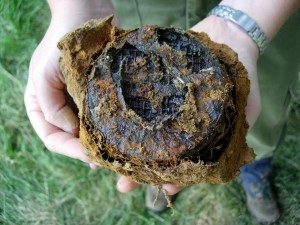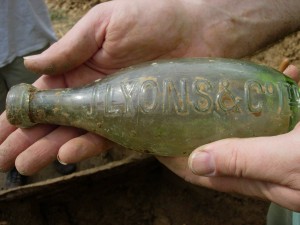Concrete Evidence Thursday, August 9th, 2007
|
|
|
|
|
For anyone interested in the bunker excavated in Trench 1 by Kirsty and her magnificent team there is on-going discussion at the Great War Forum. Regulus and Jack Sheldon (author of some excellent works on German war experience) have been very generous with information and images, including a machine gun post that looks suspiciously like our position.
_
More at:
http://1914-1918.invisionzone.com
|
|
|
|
|
|
Filed under: A Dig Diary by
admin
1 Comment »
|
|
Trench 3 exploits – on the edge! Wednesday, August 8th, 2007
|
|
|
|
|
What a great week! Here are some pics and my experience of Trench 3.
_
We made a good start with Dan and Sue hard at work but it’s all too much for Bex who needs a sit down.
_
Felix and Joel do some filming for ABC while Steve encourages the boys digging with a song(?). Hang on – is that Mat actually working in the trench?! Surely not when he’s just had his nails done! Our Belgian diggers look on from behind our mounting and long barrow like spoil heap…
_
Steve shows our trench finds to the WWI re-enactment guys when they visit the site. Very spooky!
_
More filming by the ABC guys with Martin and Richard (check out the uniform!), the Auzzie boys (Mat and Mike), our geophys whizz Peter aka”the Colonel” and Gantrand, our Belgian EOD guy, at hand to deal with any volatile divas!
_
Last but not least – the hard core of the team on Friday afternoon, still digging and still smiling! Steve is in the Auzzie recut of the German frontline trench. The Auzzie trench measurements matched the historic records exactly.
_
And finally…
_
Since the dig I have been enthused to find out more about my family in the Great War. My Grandad, born 1897, joined the Leicesters PBI (Poor Bloody Infantry as my dad calls it) in 1914 at the age of 17 and spent the entire war either in France or Belgium. He was one of the very lucky ones who came home, and went on to also “survive” WWII as part of the British Expeditionery Force. I now hope to do some more digging (of the research kind) to find out where the Leicesters went and therefore what he might have experienced. I may even have trodden in his footsteps last week!
_
|
|
|
|
|
|
Filed under: A Dig Diary by
admin
Add a Comment »
|
|
Page 8 Lovely Wednesday, August 8th, 2007
|
|
|
|
|
As Featured in the Nord Eclair, Mr Litherland and the excavation team…
_
|
|
|
|
|
|
Filed under: A Dig Diary by
admin
Add a Comment »
|
|
The Team Wednesday, August 8th, 2007
|
|
|
|
|
_

_
So here we are, the core of the team, including the field archaeologists, conservators, artist, geophysicist and anthropologist. Missing are Patrick and Nicolas, as well as a number of other locals, and Gontrand who was sorting out his Para-Commando veterans following their parade at the Last Post Ceremony. Also present with the group are our two Australian guests, Matt McLachlan (author) and Michael Molkentin (historian) who joined us on site with a film crew from ABC. We wait to see whether their recording of our work will make it to a final cut documentary.
_
We are standing in front of the Ploegsteert Memorial to the Missing, where we were honoured to take part and lay a wreath on behalf of the group. Our wreath party included Tori, who has a great uncle on the memorial and Ralph who is our expert on German military history. The Australian Defence Force also laid a wreath and were represented by Lt Col Paul Smith.
_
It is an odd thing to excavate a site and then to attend ceremonial at a monument to the Fallen, some of whom may lie in the fields where we had been working. This is one of the odd dynamics of working in contemporary archaeology, as is the possibility of identifying any skeletons. As it was, we didn’t find any bodies.
|
|
|
|
|
|
Filed under: A Dig Diary by
admin
Add a Comment »
|
|
Conservation Wednesday, August 8th, 2007
|
|
|
|
|
So the next stage of the work is to ensure that the delicate finds that require conservation work are looked at. To this end, Rob Janaway of Bradford University was on site at the end of the dig. ob was able to advise on suitable methodologies (a new ‘First Aid for Finds’ needs to be written when it comes to the archaeology of the Great War). Objects such as leather, copper alloy, and the gasmasks found in trench 3 will be conserved prior to their being photographed and recorded. Ultimately they will be returned to Belgium to join the rest of the finds.
_
Objects below for Conservation – German gasmask filter (held rather lovingly by Jo it must be said..) and the Lyons bottle from the sap leading to the Lewis position (otherwise known as Dan’s trench)
_
 _
_

|
|
|
|
|
|
Filed under: A Dig Diary by
admin
Add a Comment »
|
|
en retour… Tuesday, August 7th, 2007
|
|
|
|
|
Hello again
_
We’re back from the Front, feeling tired but happy…
_
Big thanks to all the team, to Patrick and his friends from the historical society, to the boys from the RLC who came for a site tour an ended up digging a big hole for us (with beautiful straight edges I might add), to Gontrand and to Tony the barman (who knows why). The lovely folk from Zonnebeke Museum also get thanked for their kind words and end of day gift.
_
More pictures as we go!
_
Martin
|
|
|
|
|
|
Filed under: A Dig Diary by
admin
1 Comment »
|
|
Projekt Plugstreet: Abschlussbericht Monday, August 6th, 2007
|
|
|
|
|
Der Donnerstag und Freitag wurde noch einmal ausgenutzt um einen weiteren ehemaligen Schützengraben auszuheben. Dieser wurde erneut mithilfe der Geophysik ausfindig gemacht und ließ vielversprechende Resultate erwarten. Es wurden hier neben jeder Menge Stacheldraht auch wieder einige andere Funde gemacht u.a. eine Mundharmonika, Glasflaschen, Ampullen und Hemdknöpfe. Gegen Nachmittag wurden dann die letzten Fotografien und Zeichnungen gemacht. Anschließend wurden die Schaufeln und Kellen niedergelegt und zum gemeinsamen Gruppenfoto aller Beteiligten aufgerufen. Am Abend ging es dann zu einem Kriegerdenkmal in Ploegsteert. Hier wurde unter der Begleitung von Dudelsackklängen ein Kranz niedergelegt und so den Soldaten gedacht.
_
Im Auberge, ein gemütliches kleines Restaurant, wurde gemeinsam gespeist und die Gedanken über die vergangenen Tage ausgetauscht. Am Samstag blieb dann für einige noch ein bisschen Zeit Museen und Soldatenfriedhöfe in der Nähe zu besuchen. Anschließend hieß es dann Abschied nehmen. Emailadressen und Telefonnummern wurden eifrig ausgetauscht und man freut sich schon auf ein gemeinsames Wiedersehen im nächsten Jahr. Das Projekt war somit ein Erfolg und stimmte die Projektleiter sehr zufrieden, so dass bereits an eine Fortsetzung des Projektes gedacht wird.
_
Projekt Plugstreet war eine sehr gute Erfahrung. Ich habe jede Menge gelernt, viele interessante Menschen kennen gelernt und viele neue kulturelle Eindrücke erlebt. Die Erinnerung an den Ersten Weltkrieg ist allgegenwärtig und bleibt besonders durch die vielen Museen und Denkmäler erhalten.
_
Special thanks to Martin and Richard who gave me the opportunity to participate in Project Plugstreet. I am glad I met all these great people and it was a pleasure being a part of this team. It has been a great time and I look forward to seeing you next year. Thank you.
|
|
|
|
|
|
Filed under: A Dig Diary by
admin
Add a Comment »
|
|
Last images for the evening Monday, August 6th, 2007
|
|
|
|
|
_
1) The delectable Carla holding a Pipe stem found in the sap of the Australian Lewis gun pit. Especially poignant given the diary accounts of the Australian 3rd Div of their troops advancing with rifles slung and smoking their pipes….
_
2) Some Webbing buckles, again from Dan’s Lewis gun sap.
|
|
|
|
|
|
Filed under: A Dig Diary by
admin
Add a Comment »
|
|
Images 2 Monday, August 6th, 2007
|
|
|
|
|
Some more images of the site
_
1) German stick grenade – one of several examples found on site and dealt with by Gontrand, ex of DOVO
_
2) British Mills bomb (again, Gontranded)
_
3) German Bunker found in the German fire trench. If anyone questions the merits of archaeology and the great war, well this bunker was never mentioned in ANY diaries of the battle (Battalion or otherwise), is not visible in aerial photos or trench maps. Even the farmer did not know of its existence until Kirsty, Tori and the gang worked their concrete-maiden magic
_
4) Dan excavating the sap dug by the Australians to provide a T-head for their Lewis gun as part of the refortifying of Ultimo Crater. This produced bottles, pipe stems, food tins and the contents of a brazier.
_
5) Lovely result as this trench is finished – note wriggly tin sides and iron strap holding them in place
|
|
|
|
|
|
Filed under: A Dig Diary by
admin
2 Comments »
|
|
Some images of the work Monday, August 6th, 2007
|
|
|
|
|
At an early stage yet, but thought we should add some images of the site and of finds. Look out for images of the team in action soon.
_
1) Remnants of Factory Farm in the Crater Upcast
_
2) British High Explosive shell fuse (dated 1915 but adapted in17) found in German fire trench
_
3) British (or Australian!) .303 clip
_
4) Great War re-enactors that took part in the Passchendale 90th anniversary march visit the site
_
5) Pocket knife from the German fire trench
|
|
|
|
|
|
Filed under: A Dig Diary by
admin
Add a Comment »
|
|
|
|
|
|